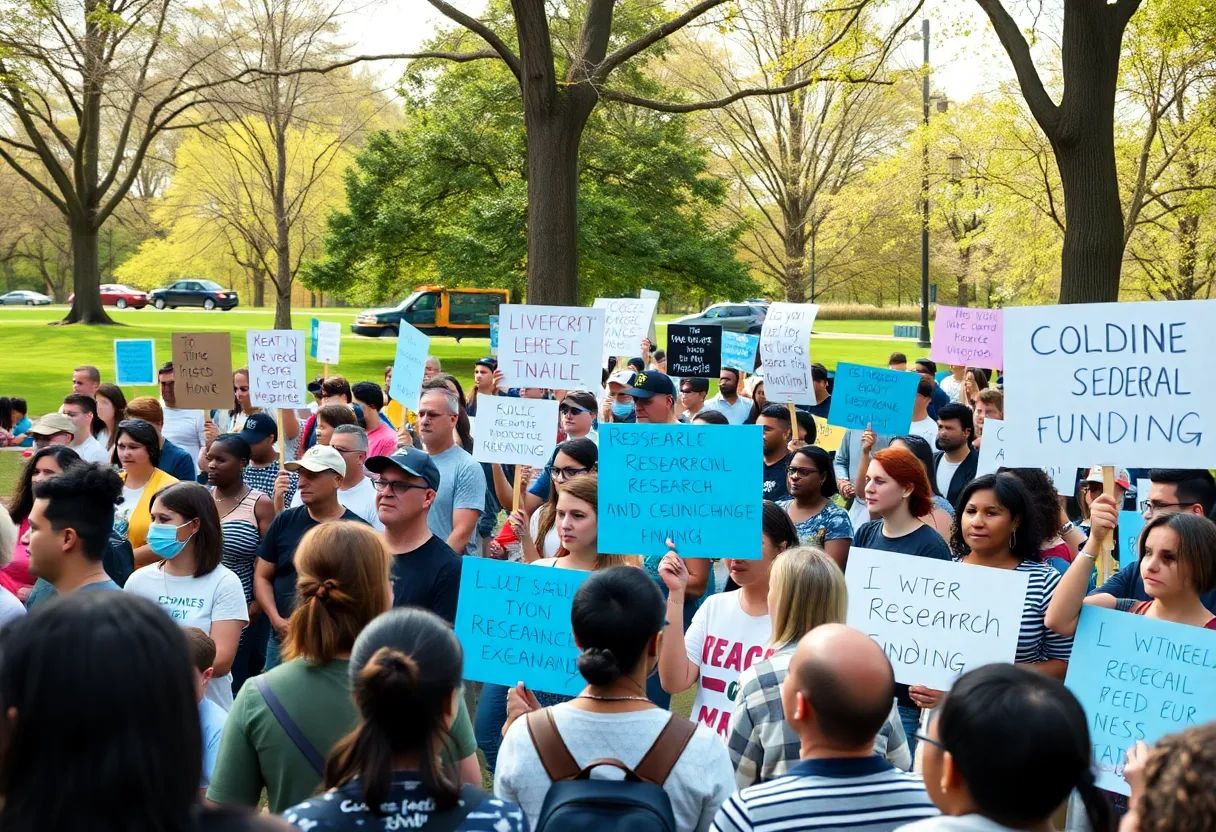News Summary
Nearly 300 community members rallied in Railroad Park on March 7, 2025, protesting cuts to federal research funding, particularly from the NIH. Participant concerns focused on the potential negative effects these funding pauses could have on local health and research, underscoring the economic implications for Birmingham and the vital role of organizations like UAB in public health and economic resilience.
Birmingham Residents Rally Against Federal Research Funding Cuts
Nearly 300 community members gathered at Railroad Park in Birmingham on March 7, 2025, to protest recent federal pauses to funding from organizations such as the National Institutes of Health (NIH). The rally highlighted the potential repercussions of funding cuts for research vital to local health and economic development.
Impact on Local Health and Research
Strong concerns were voiced by attendees about the cascading effects of federal funding reductions. Birmingham resident Mara Jambor expressed how critical NIH-supported research was to her survival, stating her life-saving treatment was a direct result of efforts funded by these agencies. Such personal testimonies resonated with many as they articulated fears regarding the adverse impacts of potential funding cuts on community health and medical research.
Officials from the University of Alabama at Birmingham (UAB) indicated that federal funding reductions could cost the institution as much as $70 million annually. This figure signifies not only a loss for UAB but also extends to other state universities, which could face similar financial challenges. The pause in grant reviews and the operation of funding councils raises alarms about the sustainability of critical research projects.
Economic Implications for Birmingham
As the largest employer in the state, UAB’s fiscal health is integral to the Birmingham economy. Mayor Randall Woodfin emphasized the importance of sustained research funding for economic growth and public health within the community. UAB received $774.5 million in research grants in 2023, with a significant portion, $413.7 million, stemming from NIH funding. The institution is ranked among the top 1% of NIH-funded entities, a status that amplifies concerns about the local economy facing ripple effects from funding cuts.
Concerns from Research Personnel
The rally showcased voices from various stakeholders within the research community. Neuroscientist Kristina Visscher underscored the importance of the scientific workforce for both the economy and public health. Trainees, such as Joshua Huffines, reflected on the uncertainty surrounding their future job prospects due to funding delays, which could hinder their ability to support families. Other graduate students shared similar worries, with reported funding pauses affecting recruitment for critical research training programs.
Research initiatives geared towards vulnerable populations were highlighted as potential casualties of funding interruptions. Community health studies, including those aimed at understanding Parkinson’s disease and lung health, are facing potential setbacks. For instance, Amanda Finn mentioned delays in reauthorizing a lung disease study intended to benefit rural residents in Alabama, which has become a pressing concern in light of the current funding landscape.
Federal Legal Context
A federal judge recently blocked the Trump administration’s cuts to the NIH’s indirect cost rate, providing a temporary reprieve as litigation on the matter continues. However, uncertainty looms as organizations await further guidance regarding future funding opportunities. Individuals like doctoral student Caitlyn Sebastian also face recruitment halts for critical NIH programs, emphasizing how quickly funding issues can affect ongoing research efforts.
Overall, organizations like HEALTHe Birmingham, which focus on the health impacts of public housing, find themselves at risk of losing crucial funding if federal support diminishes. These funding cuts also highlight broader policy implications, potentially exacerbating health disparities among local communities.
Conclusion
The Birmingham rally reflects a growing apprehension regarding the local impact of federal research funding cuts. As the community rallies in support of sustained funding, the overarching concern remains how these cuts will affect not just research institutions, but ultimately, public health and the economic resilience of the area.
Deeper Dive: News & Info About This Topic
HERE Resources
Birmingham Teachers Use Data to Boost Early Childhood Engagement
Birmingham Faces NIH Funding Cuts Threatening UAB
Birmingham Faces Major Threat from NIH Funding Cuts
UAB Faces NIH Funding Cuts: Impact on Birmingham’s Healthcare
UAB’s Heersink School of Medicine Achieves High NIH Ranking
University of Alabama System Unveils Major Campus Developments
Birmingham Conference Sparks Vital Conversations on Diversity, Equity, and Inclusion
Major Construction Projects Announced at University of Alabama
Alabama Lawmakers Propose Changes to School Funding System
Proposed NIH Funding Cuts Spark Legal Battles Nationwide
Additional Resources
- AL.com: Birmingham Residents Rally Against Federal Research Funding Cuts
- CBS 42: UAB, Birmingham Mayor Release Statements on Medical Research Funding
- Birmingham Times: As NIH Announces Cuts, UAB Could Lose Hundreds of Millions in Research Grants
- AL Daily News: NIH Funding Cuts Could Jeopardize Life-Saving Research in Alabama
- Wikipedia: National Institutes of Health







